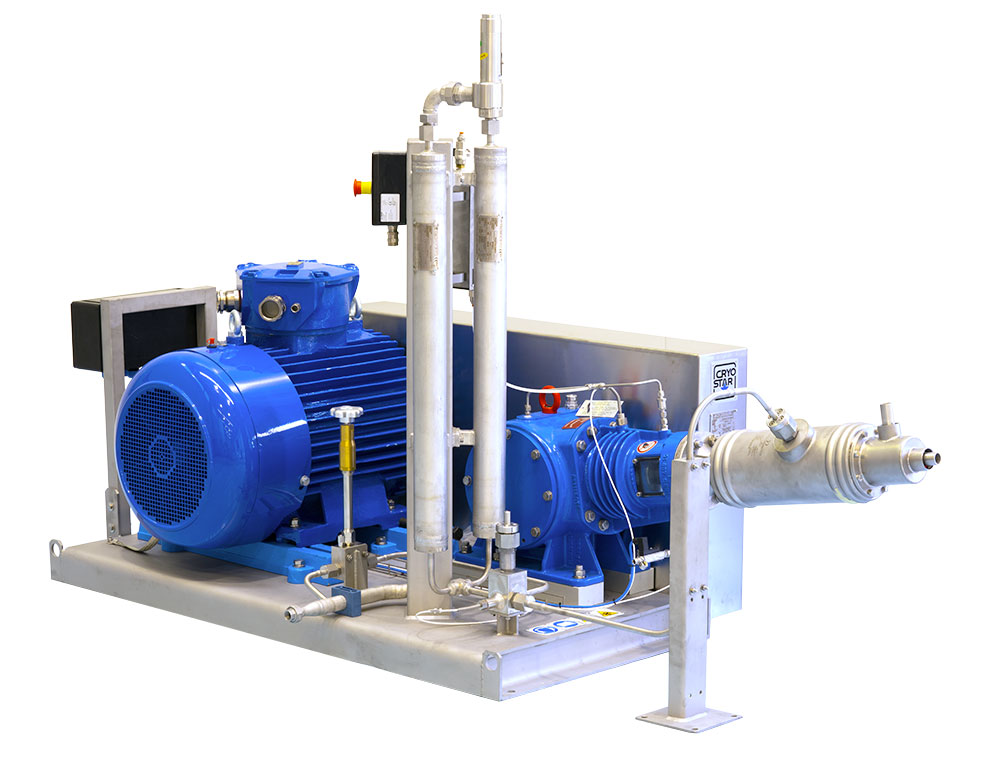
Cryostar has developed a range of liquid hydrogen piston pumps with large capacities, small footprints, and competitive TCO, as the ideal system for increasing the pressure of hydrogen.
The A-MRP 40/55-K LH2 cryo pumps are explosion proof skid mounted piston pumps designed for simple and safe installation for use with a liquid hydrogen source. Three different sizes are available, with capacities ranging from 6 to 190 kg/h with easy flow adjustment.
The A-MRP 40/55-K LH2 cryo pumps can be used with all types and makes of LH2 tanks and ISO containers, making them particularly versatile and easy to integrate with existing setups.
Thousands of A-MRP cryogenic pumps are already in operation all around the world. Its patented super insulated A-MRP LH2 variants have been in operation for more than 10 years and have proven to be very reliable and offer the longest maintenance interval on today’s market.
CUSTOMER BENEFITS
These LH2 pumps offer several advantages for hydrogen refueling stations:
- Direct filling at up to 60gr/sec with a single pump (dual pump use possible)
- Low specific energy consumption: 0.4 kWh/kg H2 (>80% energy savings vs compressors)
- High-purity hydrogen gas fueling (99.995%)
- No chiller required (Important source of OPEX.)
- <30 sec to reach H2 Filling t° as required by SAEJ2601
Did you know?
Almost 15% of an HRS’ TCO is dedicated to cooling the gas. Thanks to the frigories contained in LH2, the hydrogen needs no additional cooling at the dispenser level when using A-MRP 40/55-K LH2 pumps, resulting in to even more savings!
APPLICATIONS
FOCUS on HRS applications
How to maximize revenue of 70 MPa LH2 stations
Compression is by far the most expensive part of running a hydrogen station, and can account for up to 25% of the cost of dispensing H2!
We have observed that the 90 MPa liquid hydrogen pumps that are currently available do not offer both cost-effectiveness and high reliability. In addition, hydrogen compressors are frequently oversized, due to a lack of consistent inlet pressure, and are underutilized during off-peak hours.
Therefore, our approach is to achieve 90 MPa of pressure through two stages of compression.
During the first stage, the gas is compressed to 45MP using a reliable, cost-effective A-MRP40/55-K LH2 pump and a heat exchanger that consolidates the inlet pressure of a second stage of compression to 90MPa, achieved using a high throughput booster compressor, which remain compact and cost effective, thanks to a constant compression ratio of 2:1.
This hybrid approach represents a 50-75% reduction in the cost of compression as compared to a single 90 MPa pump or compressor, which works out to 1.50 euro per kilogram of hydrogen! Contact us for more information.
How to optimize dual 35/70 MPa LH2 filling stations
In order to maximize their utility, hydrogen refueling station tend to be used to fill both light-duty and heavy-duty vehicles at 35 MPa and 70 MPa. When using a single compression module, however, it is impossible to adjust the filling capacity for different types of vehicles. As LD and HD vehicles have different tank capacities and filling rate requirements, the design of the compression unit is often suboptimal.
In LH2 stations, this obstacle can be overcome by the implementation of a hybrid liquid-gas compression unit, which consists of an initial compression stage that uses an LH2 cryo pump, such as the proven A-MRP40/55-K LH2 and a second compression stage that uses a simple booster compressor.
The throughput capacity of each stage of compression is then adjusted for the vehicles’ specific requirements, resulting in an optimized cost of compression per kg of H2! Contact us for more details.
POTENTIAL DEVELOPMENT
Cryostar’s range of A-MRP40/55 K-LH2 pumps covers most of the current LH2 applications. However, new applications for H2 are sure to appear in the future, for example in the aviation industry, for which a new type of LH2 pump might be required. Should you find yourself in this situation, feel free to contact us so we can discuss the potential development of a suitable pumping solution.
